The most effective indoor plants for eliminating harmful VOCs include the versatile Peace Lily, which removes major toxins within 48 hours, and the low-maintenance Snake Plant, which purifies air even at night. You'll also want to evaluate English Ivy, Bamboo Palm, and various Dracaena varieties, as they target specific compounds like benzene and formaldehyde. Adding Chinese Evergreen, ZZ-Plant, Boston Fern, Golden Pothos, and Areca Palm to your collection will create a powerful natural air-purification system. Let's explore how to maximize these plants' air-cleaning potential.
Understanding VOCs and Their Impact on Indoor Air Quality

While many homeowners focus on outdoor air pollution, volatile organic compounds (VOCs) pose a significant health risk inside our homes. You'll find these harmful chemicals in everyday items like paints, cleaning supplies, furniture, and personal care products.
What's concerning is that indoor VOC levels are typically 2 to 5 times higher than outdoor concentrations. Proper ventilation and monitoring are crucial steps in maintaining safe indoor air quality.
At low levels (0-400 ppb), you mightn't notice immediate effects. However, when VOC concentrations rise between 400-2,200 ppb, you could experience headaches, dizziness, and respiratory issues.
Higher levels can cause severe health problems, including organ damage and increased cancer risk. You're particularly vulnerable if you're elderly, very young, or have existing respiratory conditions.
That's why understanding VOC sources and their impact is essential for protecting your family's health.
The Science Behind Plant-Based VOC Filtration
You'll find that plants remove VOCs through a remarkable process involving both their leaves and roots, with the leaves absorbing pollutants directly from the air while conducting photosynthesis.
Research has shown that plants effectively eliminate toxins like formaldehyde and benzene from indoor spaces.
The absorbed VOCs then travel through the plant's system to the root zone, where specialized soil microorganisms break them down into harmless compounds.
This efficient natural filtration system works continuously, as plant leaves and root microbes work together to metabolize, translocate, and eliminate harmful VOCs from your indoor air.
Plant Absorption Process Explained
Three key stages define how plants eliminate VOCs from indoor air.
First, your indoor plants absorb VOCs through their leaves, where these harmful compounds enter the plant's tissue structure. During this initial phase, the plant's natural metabolic processes facilitate the uptake of these airborne pollutants. Similar to industrial activated carbon systems, plants provide a natural and sustainable method of VOC removal.
Next, the absorbed VOCs don't stay in the leaves. Instead, they're transported down to the plant's root zone, where the real transformation begins.
In the final stage, beneficial microbes living in the soil take over. These microscopic organisms treat the VOCs as a food source, breaking them down into harmless components. This process creates a continuous cycle of purification, as your plant's roots also absorb air and water solutions, enhancing the overall cleaning effect.
Leaf Surface Chemical Reactions
The microscopic world of leaf surfaces reveals fascinating chemical interactions that drive VOC filtration. Your indoor plants don't just trap pollutants – they're hosting complex chemical reactions that transform harmful VOCs into less toxic compounds.
When VOCs land on leaf surfaces, they interact with surface waxes and can become embedded in the leaf structure, where they undergo various transformations.
Here are three key chemical processes happening on your plant's leaves:
- VOCs react with oxygen more intensely in polluted areas, creating secondary organic aerosols.
- Leaf waxes trap particles up to 70.4 μm in size, with 60% being washable by water and 40% by chloroform.
- Environmental factors like temperature and light modify how VOCs interact with leaf surfaces, affecting their breakdown and transformation.
These chemical reactions work alongside microbial processes to purify your indoor air effectively.
Root System VOC Breakdown
Plant roots serve as natural filtration powerhouses, working beneath the soil to break down volatile organic compounds (VOCs) through complex biochemical processes.
Your indoor plants' roots release specific compounds like benzonitrile and benzothiazol that actively combat harmful substances, while also emitting n-alkanes and terpenes during normal growth.
What's fascinating is how your plants' root systems don't just filter VOCs – they transform them. The roots disrupt harmful compounds by altering K+ ion flow and pH gradients, effectively breaking down unwanted chemicals.
They'll even attract beneficial microbes while repelling harmful ones, creating a healthier growing environment. This natural filtration system is so effective that scientists are studying its potential applications in sustainable agriculture and indoor air purification methods.
Snake Plant: The Ultimate Air-Purifying Powerhouse
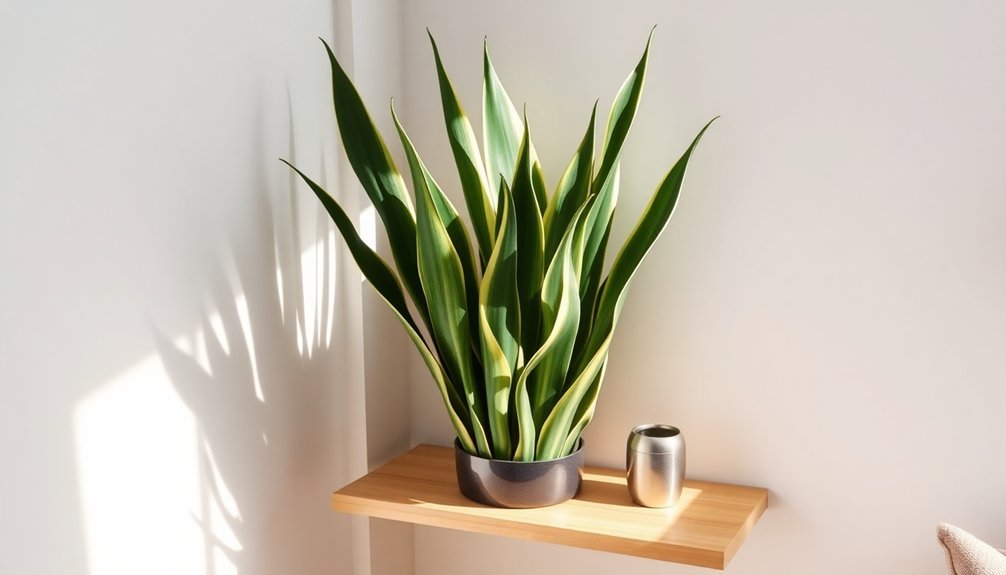
Known as nature's most efficient air purifier, snake plants stand out as remarkable defenders against indoor air pollution.
You'll find these powerhouse plants can eliminate up to four major toxins from your home in just 48 hours, while releasing fresh oxygen and moisture into the air.
The Golden Snake Plant, along with its 70+ varieties, works through a sophisticated process of photosynthesis and transpiration to transform harmful pollutants into nutrients.
- Removes benzene, formaldehyde, and trichloroethylene through leaf absorption
- Converts CO2 into oxygen primarily at night, improving your sleep quality
- Creates a natural suction effect that pulls in and traps airborne pollutants
You won't find a more low-maintenance air purifier – these hardy plants thrive in various light conditions and need minimal watering, making them perfect for busy households.
Peace Lily's Triple Threat: Beauty, VOC Removal, and Low Maintenance
You'll find peace lilies to be remarkable indoor plants that combine stunning white blooms with dark green foliage while effectively removing harmful chemicals like TCE and benzene from your air.
Your peace lily won't demand much attention, thriving with basic care like indirect sunlight and occasional watering.
These elegant purifiers work continuously to clean your indoor air, making them an excellent choice for bathrooms and kitchens where they can also enjoy higher humidity levels.
Elegant White Blooms
When seeking an indoor plant that combines sophistication with functionality, the peace lily stands out as a remarkable triple threat. Its elegant white blooms create a striking contrast against dark green, glossy leaves, making it a perfect centerpiece for any room.
You'll enjoy these pristine flowers for several weeks, and they'll reward you with a sweet, subtle fragrance that enhances your space.
For maximum visual impact, you'll want to know these key features:
- Peace lilies can grow up to 3-6 feet tall, creating a dramatic focal point in your indoor landscape.
- The white blooms appear periodically throughout the growing season, ensuring long-lasting beauty.
- The plant's compact growth habit makes it suitable for both floor displays and tabletop arrangements.
Powerful Chemical Fighter
Beyond its stunning aesthetics, the peace lily stands as a powerful warrior against indoor air pollution.
You'll find this NASA-endorsed plant effectively removes dangerous chemicals like benzene, formaldehyde, and toluene from your air, with the ability to eliminate up to 60% of indoor pollutants.
What makes the peace lily particularly impressive is its effectiveness against multiple VOCs simultaneously, though it performs best when targeting single gases.
It's also a natural humidifier, releasing water vapor that keeps your air moisture-balanced and breathable.
Whether you place it in your home or office, this resilient fighter thrives in dappled sunlight and temperatures above 60°F.
You can even grow it in water alone, making it an adaptable solution for combating "Sick Building Syndrome" and improving your indoor air quality.
Simple Care Requirements
The peace lily's three standout qualities – aesthetic beauty, VOC removal, and minimal maintenance – make it an ideal houseplant for busy homeowners.
You'll find its care requirements surprisingly manageable, even if you're new to plant parenthood.
Keep these essential care tips in mind:
- Place your peace lily in bright, indirect light, preferably near an east-facing window, and protect it from cold drafts and direct sunlight.
- Water only when the top two inches of soil feel dry, using purified or rainwater, and maintain temperatures between 16-21°C (61-70°F).
- Boost humidity through regular misting, and feed with diluted liquid fertilizer during spring and summer months only.
These simple requirements will keep your peace lily thriving while it purifies your indoor air and enhances your space with its elegant blooms.
English Ivy: A Versatile VOC Fighter for Any Room

As one of nature's most effective air purifiers, English ivy stands out for its remarkable ability to eliminate harmful volatile organic compounds from indoor spaces. You'll find it particularly effective at removing benzene, formaldehyde, and trichloroethylene through its natural phytoremediation process. The plant's extensive leaf surface area traps pollutants while its root system breaks them down.
| Pollutant | Removal Rate | Time Frame |
|---|---|---|
| Benzene | 89.8% | 24 hours |
| Fecal Matter | 94% | 12 hours |
| Mold Spores | 78% | 12 hours |
While it's incredibly effective in contained spaces, you'll need to keep it away from pets and children as it's toxic if ingested. Consider placing it on high shelves or hanging baskets where it can thrive with minimal maintenance while purifying your air.
Bamboo Palm: Tropical Elegance Meets Chemical Defense
While many indoor plants offer air-purifying benefits, bamboo palms stand out for their exceptional ability to combat VOCs while adding tropical sophistication to your space.
These elegant plants can remove up to 90% of indoor air pollutants, including formaldehyde, benzene, and carbon monoxide, making your home considerably healthier.
You'll appreciate these key features of the bamboo palm:
- Grows up to 12 feet tall, creating a stunning visual impact with its feathery fronds
- Thrives in indirect sunlight and requires minimal maintenance, perfect for busy plant parents
- Helps maintain ideal humidity levels while reducing respiratory issues and stress
Keep your bamboo palm healthy by maintaining moist soil and occasional misting.
Watch for yellowing leaves and common pests like spider mites, but don't worry – these issues are easily manageable with proper care.
Dracaena: Multiple Varieties for Targeted VOC Removal
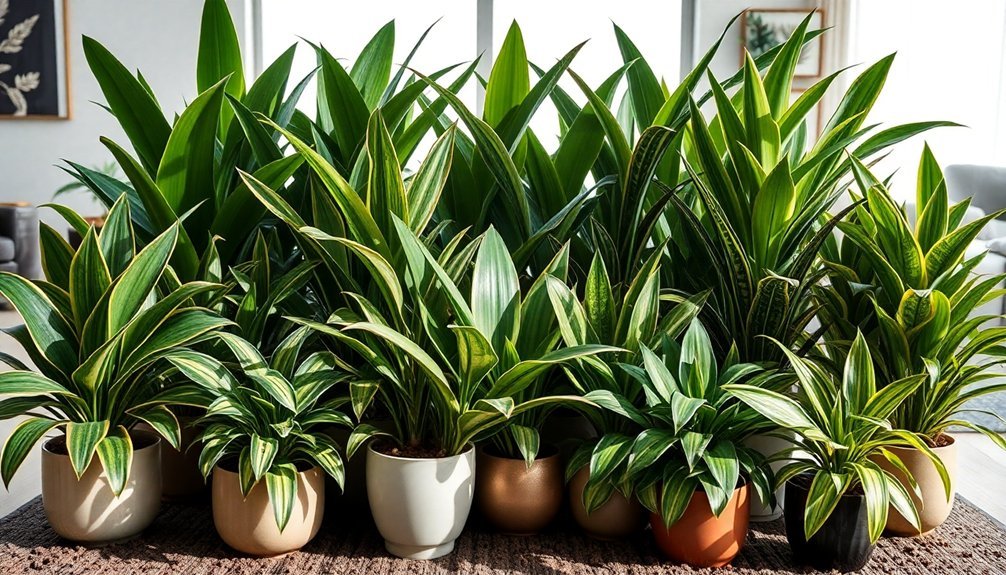
Dracaena's impressive ability to remove 96% of formaldehyde and 94% of acetone from indoor air makes it a top choice for your home's air purification needs.
You'll find several varieties of this adaptable plant, including Dracaena compacta, that thrive in both indirect light and low-light conditions while steadily eliminating harmful VOCs through their leaves and root systems.
While slower than mechanical air purifiers, your Dracaena will naturally combat indoor pollutants with minimal care requirements, needing only well-draining soil and occasional misting to maintain its air-cleaning capabilities.
Dracaena Species Common Types
The versatile Dracaena family offers several powerful VOC-fighting species, each with unique characteristics and growing requirements.
You'll find that Dracaena marginata, known as the Dragon Tree, can grow up to 8 feet indoors with its distinctive strap-like leaves in tricolor variations.
The Dracaena fragrans stands out for its fragrant flowers and variegated green leaves, while Dracaena deremensis features broader leaves with light margins.
When choosing your Dracaena, consider these popular varieties:
- Janet Craig Compacta – A slow-growing plant with dark green, glossy leaves that's perfect for low-light areas
- Warneckei – Distinguished by its yellow-gold and green sword-shaped leaves growing in groups
- Gold Dust (Florida Beauty) – A compact, bushy option with unique creamy yellow spots on rounded leaves
VOC Removal Effectiveness
Scientific research has proven Dracaena plants to be powerful air purifiers, with different varieties excelling at removing specific volatile organic compounds (VOCs).
You'll find Dracaena deremensis (Warneckei) particularly effective, removing over 50% of both benzene and formaldehyde in controlled studies. If you're dealing with acetone exposure, consider Dracaena fragrans, which eliminates up to 94% of this common solvent.
While these plants aren't as successful with dichloromethane and trichloromethane, they maintain consistent removal rates in various conditions.
For best results, you'll want to place your Dracaena in well-lit areas, as light enhances their VOC-removing capabilities.
Consider combining different Dracaena species with other air-purifying plants like Bromeliad or Spider Plant to target a broader range of indoor air pollutants effectively.
Light and Care Requirements
While optimizing your Dracaena's VOC-removing abilities requires proper light exposure, you'll need to strike a delicate balance. Most Dracaena varieties thrive in bright, indirect light, making east and west-facing windows ideal locations when plants are placed 3-5 feet away from the glass.
If you've got variegated Dracaena, they'll need brighter indirect light to maintain their striking patterns.
For peak growth and VOC removal, follow these key care guidelines:
- Water when the top inch of soil feels dry, avoiding waterlogged conditions
- Position your plant away from direct sunlight to prevent leaf scorching
- Use artificial lighting for 12 hours daily if natural light is insufficient, keeping LED or fluorescent lights 12-18 inches from the plant
Remember to maintain moderate humidity by occasional misting, especially in dry indoor environments.
Selecting the Right Air-Purifying Plant for Your Space
Selecting an ideal air-purifying plant involves balancing your specific needs with the plant's capabilities and care requirements.
If you're a busy person with limited time for plant care, consider low-maintenance options like the Snake Plant or Golden Pothos, which both tolerate infrequent watering and low light conditions.
For homes with pets, you'll want to prioritize safety. The Areca Palm and Boston Fern are excellent pet-safe choices that also remove multiple VOCs.
If you're dealing with specific pollutants, the Peace Lily is highly effective at removing five different VOCs, though it's not pet-friendly.
For darker spaces, the Chinese Evergreen or ZZ-Plant will thrive while still providing air-purifying benefits.
In bright, indirect light, the Spider Plant offers both easy care and formaldehyde removal.
Optimal Plant Placement for Maximum VOC Reduction
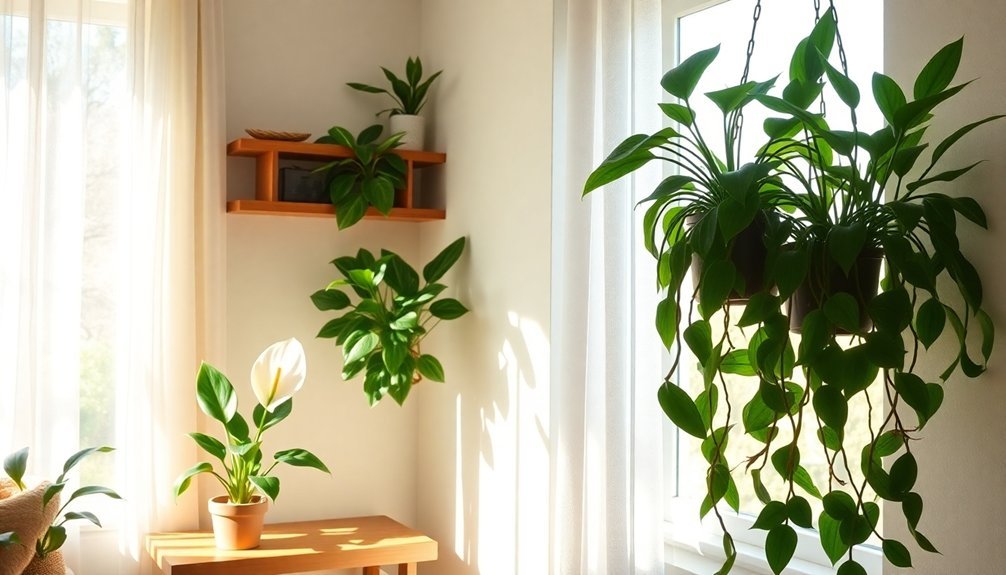
To maximize your indoor plants' VOC-reducing capabilities, proper placement and density are essential factors.
You'll need 10-1,000 plants per square meter for significant results, though even 2.44 plants per square meter can reduce formaldehyde by 11%. For an average 167.2 m² space, aim for 15-18 air-purifying plants in 18-24 cm containers.
For ideal VOC reduction, follow these key strategies:
- Place plants in areas with minimal air circulation, as excessive ventilation can reduce their effectiveness.
- Position plants strategically in rooms with high VOC concentrations, such as spaces with new furniture.
- Install plants to cover at least 10% of the room space, particularly in areas without air conditioning.
Monitor VOC levels regularly to adjust placement for maximum impact.
Maintaining Your Natural Air Purification System
Maintaining a thriving indoor air purification system requires consistent attention to four key areas: watering, soil health, environmental conditions, and proper plant care.
Check the top inch of soil before watering, as each plant has unique moisture needs. Snake Plants and Spider Plants can tolerate neglect, while Peace Lilies need regular watering. Use well-draining soil and add balanced fertilizer during growth periods to optimize air-purifying performance.
Monitor humidity and temperature levels, especially for sensitive plants like Boston Ferns. While Snake Plants adapt easily to various conditions, others may need specific environmental adjustments.
Keep your plants healthy by repotting regularly and addressing issues promptly. You'll extend their lifespan and maximize air-purifying benefits by using pots with drainage holes and propagating successfully performing plants.
Frequently Asked Questions
How Many Plants Are Needed per Square Foot for Effective VOC Removal?
You'll need an impractically large number of plants, as research shows no standard density exists. One plant can only clean 0.062 cubic meters of air per hour, making effective VOC removal through plants alone unrealistic.
Can These Plants Remove Cigarette Smoke and Its Lingering Odors?
While plants can help reduce some VOCs from cigarette smoke, they won't completely eliminate smoke or its odors. You'll need proper ventilation and other cleaning methods alongside plants for effective smoke removal.
Do Air-Purifying Plants Work Better in Combination With Mechanical Air Filters?
Yes, you'll get better results combining plants with mechanical air filters. While plants naturally absorb some pollutants, air purifiers work faster and more efficiently. Together, they provide thorough air cleaning for your space.
Which Plants Are Most Effective at Removing VOCS During Nighttime?
You'll get the best nighttime VOC removal from Snake Plants and Peace Lilies. They're effective without sunlight and continue purifying while you sleep. Bamboo Palms also work well in darkness.
Will These Plants Lose Their Voc-Removing Abilities as They Age?
You'll notice some decline in VOC removal as plants age, but with proper care and maintenance, they'll retain most of their abilities. Regular pruning, watering, and nutrient management help sustain their VOC-removing effectiveness.
In Summary
By choosing and strategically placing these air-purifying plants in your home, you're taking a natural approach to combat harmful VOCs. Remember to maintain your plants properly and you'll enjoy both their aesthetic appeal and air-cleaning benefits. Don't hesitate to mix and match different species – the more diverse your indoor garden, the more extensive your VOC elimination will be.
References
- https://www.co2meter.com/blogs/news/nasa-compiles-list-of-best-plants-to-clean-indoor-air
- https://filti.com/best-houseplants-for-clean-air-at-home/
- https://www.idyl.co.in/blogs/blog/breathe-easy-10-indoor-plants-that-reduce-vocs-in-your-home
- https://foobot.io/guides/plants-that-remove-volatile-organic-compounds.php
- https://www.wagnergreenhouses.com/blog/top-10-best-air-purifying-houseplants/
- https://getuhoo.com/blog/home/understanding-vocs-and-its-effects-on-health/
- https://beyondpesticides.org/dailynewsblog/2023/10/hidden-volatile-organic-compounds-vocs-in-indoor-air-cause-adverse-effects/
- https://www.health.ny.gov/environmental/air_quality/vocs.htm
- https://www.ubreathe.in/post/ubreathe-maximising-plant-based-air-purification
- https://journals.openedition.org/factsreports/6092
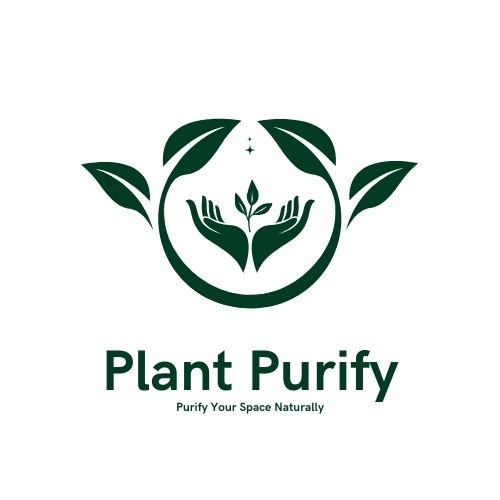
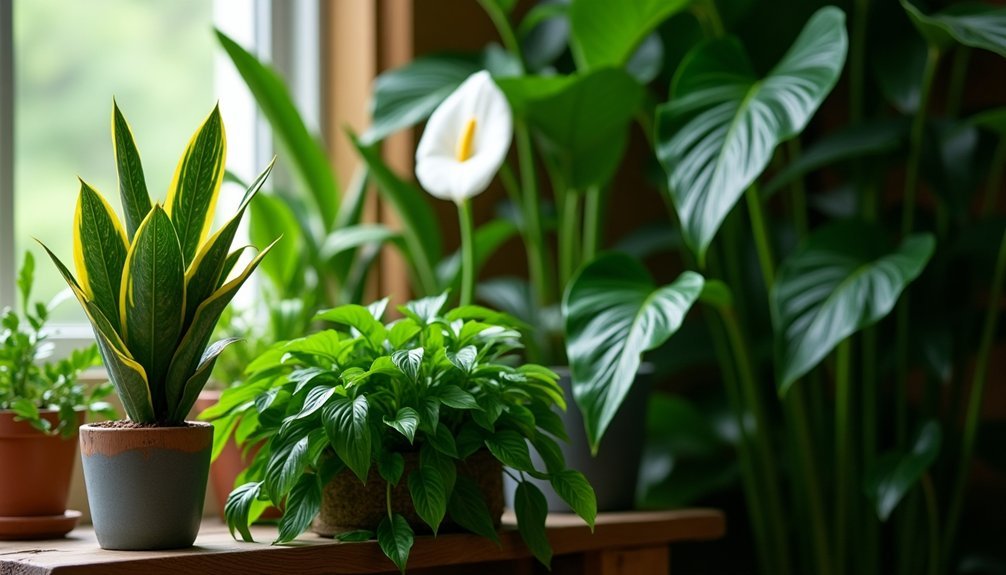


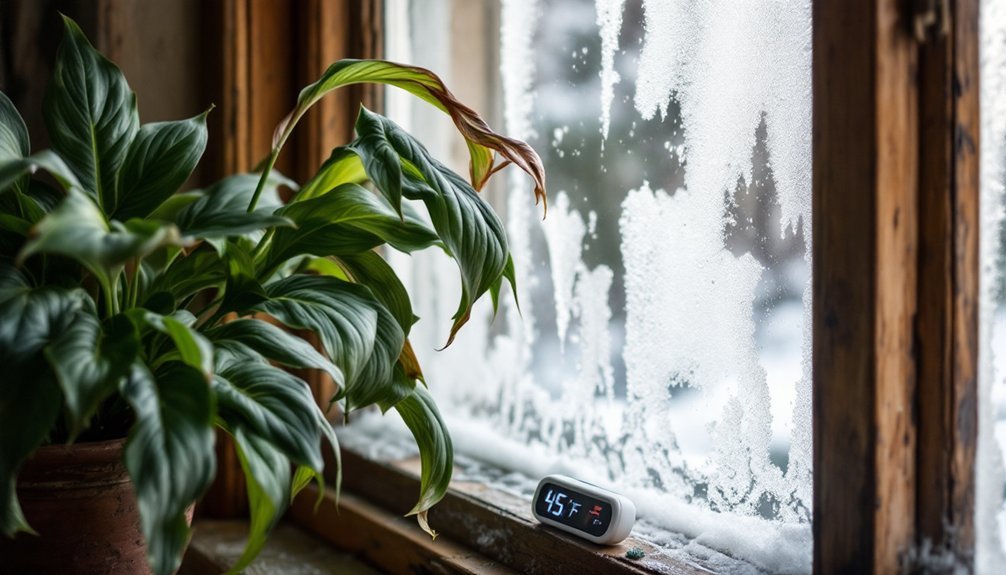
Leave a Reply